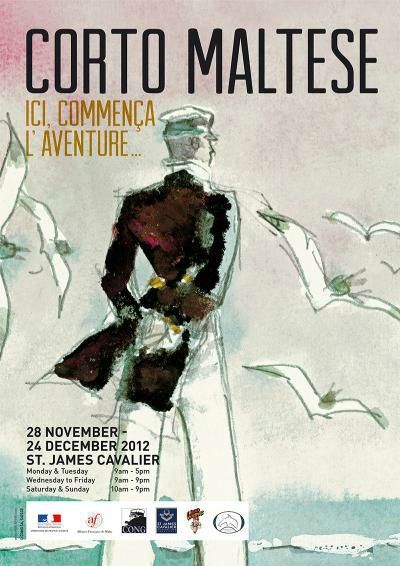Corto Maltese, ici commence l'aventure

The exhibition will be opened by the French Ambassador to Malta on Wednesday, November 28 after Marco Steiner talks in English on Corto Maltese: the Spirit and the Journey, a conversation with the audience at 6 pm in the Music Room of the Centre for Creativity. Steiner has extensively followed the tracks of Corto Maltese throughout Europe, Asia, the Carribean, Ethiopia and the Americas. Born in Rome he worked for a time as editor and translator at Lizard, the publishing house founded by Pratt. His own experience has given him a deep knowledge of Pratt’s works from a close range and his anecdotes and reminisces of the author should delight those who attend.
The fictional comic character Corto Maltese was born on July 10, 1887 in Valletta. His father was a British sailor from Cornualles while his mother was a gypsy from Gibraltar. He took up residence in Antigua but preferred to live in Hong Kong. He spent a good part of his childhood in Cordoba and his adventures took him to the four corners of the world. To honour him the Maltese erected a monument in Valletta.
Only a few years before his death in 1995, Hugo Pratt, creator of the sailor hero, was asked what inspired the name Corto Maltese. He said that he picked Corto from Spanish meaning fast; the Maltese connection he tapped from the 1930 novel ”The Maltese Falcon” by Dashiell Hammett, which was also made into a popular John Huston film starring Humphrey Bogart.
Corto was created in 1967 with the first story, The Ballad of the Salty Sea, appearing in an Italian magazine. However it was in 1970, when Corto Maltese appeared in France, that the hero hit the stands with The Secret of Tristan Bantam; Corto became an instant success with the fans of the bandes dessinées. Pratt settled in Paris.
Hugo Pratt was born in Rimini in 1927 to Rolando Pratt and Evelina Genero. He grew up in Venice. In 1937, Pratt moved with his mother to Abyssinia, joining his soldier father who was with Mussolini’s conquering army in Ethiopia. During the war Pratt’s father was captured by British troops and in 1943 died from disease as a prisoner of war near Harar. The same year, Hugo and his mother were interned in a prison camp where he would buy comics from guards. After the war he was repatriated with his mother to Venice by the Red Cross.
In 1946 Pratt committed himself to comics with his first sketches following the American style of the genre. In 1949, like many other Italians, he settled in Argentina where he started to produce several comic heroes. In 1962, now established as an artist, he returned to Italy. Basking in success with several Corto Maltese stories under his belt, the artist settled in Lausanne in 1984, where living on Lake Léman he continued to accompany his hero on several adventure trips around the globe. Ten years later Pratt fell ill and died in 1995.
Corto is the result of a particular confluence of literature, design and American cinema. To write his stories Pratt was inspired by the literature he read from different cultures: Robert Louis Stevenson, Joseph Conrad, Herman Melville, Jack London, Ernest Hemingway and Antoine de Saint-Exupéry, to whom he dedicated a significant album towards the end of his life called Le Dernier Vol. Corto sets off as a gentleman of fortune. With a long career in the British merchant navy behind him, Corto still wears white pants, a sailor’s cap and an earring on his left ear. Certainly a Mediterranean vagabond of the sea, Corto’s daring and romantic adventures follow his curious clues taking him from the South Seas to Ireland, from Buenos-Aires to Shanghai.



/http%3A%2F%2Fstorage.canalblog.com%2F71%2F20%2F420656%2F99021331_o.jpg)
/https%3A%2F%2Fassets.over-blog.com%2Ft%2Fcedistic%2Fcamera.png)
/http%3A%2F%2Fstorage.canalblog.com%2F65%2F16%2F420656%2F99180943_o.jpg)
/http%3A%2F%2Fstorage.canalblog.com%2F72%2F29%2F420656%2F99021210_o.jpg)